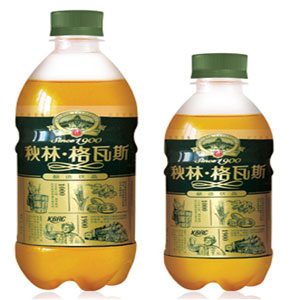Chinese Thirst for Kvass Draws Wahaha into Russian Niche
By wchung | 05 Sep, 2025
China’s growing thirst for a Russian fermented drink has enticed beverage giant Wahaha to dive into a niche long dominated by a Harbin-based company founded by a Russian immigrant.
In 1900 a Russian merchant named Ivan Churin founded Harbin Churin Food to cater to the popularity of Russian foods in China’s far-northeastern Heilongjiang province. In addition to foods like lieba (a type of Russian bread) and lidaosi (Lithuanian sausage), Churin sold kvass, a lightly alcoholic beerlike beverage made by fermenting rye bread that had been popular for centuries in Russia and eastern Europe. With alcohol content well under 1.2% — and generally closer to 0.5% — kvass is generally considered a soft drink with healthful properties, partly due to its vitamin B content and partly because it doesn’t have nearly as much sugar as most sodas.
Kvass caught on quickly in Heilongjiang. By 2009 Harbin Churin Food was producing 5,000 tons of kvass a year for a 90% share of the local market. In 2011 it decided to popularize the drink in the rest of China by moving its factory to Tianjin, a more centrally located major city that serves as Beijing’s port. The move allowed Churin to expand sales to 20,000 tons in its first year there, prompting it to set its sights on 100,000 tons within three years.
Churin’s kvass was becoming popular as a healthier alternative to soft drinks. The trend caught the attention of Wahaha, the nation’s leading beverage maker. In late 2012 with the goal of selling a billion cases of kvass a year Wahaha launched a disingenuous ad campaign that sought to persuade Chinese consumers that Wahaha was taking the lead in popularizing a drink only recently introduced to China.
Seeking an air of authenticity for its kvass Wahaha chose to launch in Harbin, the city traditionally associated with Russian culture in China. The move proved a miscalculation. Long accustomed to Churin’s kvass, the city’s residents turned up their noses at Wahaha’s product, deeming it a fake. Rumors circulated that Wahaha was merely trying to pass off as kvass an unpopular brand of beer. Wahaha was forced to retreat from Harbin and shift its efforts elsewhere.
Churin exploited Wahaha’s misstep by focusing its own marketing campaign on emphasizing its century-old tradition of making kvass using an authentic Russian recipe based on rye bread. It also claimed that its version is healthier than the malt-based version made by Wahaha. To lure consumers not accustomed to the heavy taste of Russian kvass Churin is also launching a lighter version.
The only certainly in the battle between the regional specialty brand and the upstart national giant is that a traditional Russian beverage will become China’s next big beverage trend.

Harbin Churin Food popularized a Russian fermented drink called kvass (gewasi in China) beginning in 1900.
Asian American Success Stories
- The 130 Most Inspiring Asian Americans of All Time
- 12 Most Brilliant Asian Americans
- Greatest Asian American War Heroes
- Asian American Digital Pioneers
- New Asian American Imagemakers
- Asian American Innovators
- The 20 Most Inspiring Asian Sports Stars
- 5 Most Daring Asian Americans
- Surprising Superstars
- TV’s Hottest Asians
- 100 Greatest Asian American Entrepreneurs
- Asian American Wonder Women
- Greatest Asian American Rags-to-Riches Stories
- Notable Asian American Professionals

